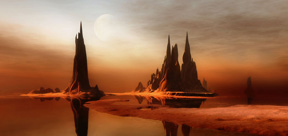|
Computer 3D fine art uses those ideas common to all traditional artists as well as the incredible tools found in a 3D modeling program. A 3D modeling program simplifies much of the work of traditional art making. With the help of reflective and transparent materials, bump mapping, atmospheric effects, lighting, camera focus and more, the work of the artist is made much easier. What makes a successful 3D computer image?
Knowledge of the traditional elements and principles of design, basic compositional concepts and a generous use of 3Dskills.
|
|
For example, look at the 3D landscape above. What can be said about it in traditional terms? |
- The Rule of Thirds – The ROT is a standard compositional tool used by artists. In the case of this landscape, the rule is expressed by the placement of the horizon line. The artist places this 1/3 from the bottom of the image. Further, the strong verticals of the cliffs divide te image into 3 well balanced areas.
- The color scheme of the image is tightly realized. It is almost a “monochromatic” or one color image… red! This gives the image a strong sense of unity, a key principle of design.
- The image uses strong value (dark to light) contrast. Contrast is another design principle. It can be expressed through value (light and dark)as in this case and/or color, shape or meaning.
|
| The 3D modeling program is used to realize the artists’ vision. |
- The strong reflection of the rocks in the water. This is done by placing a reflective material onto the plane that is used to make the water.
- The intense red quality is created using colored lights.
- The sense of deep space, the distant haze is made using a special atmospheric fog effect.
- The craggy rocks are easily made using a basic shape like a geo-sphere and the Noise modifier.
|
| Together, traditional art concepts and the 3D computer tools can create fantastic images |
| The projects in the fine art catagory are graded on a one by one basis based on the criteria above as well as the complexity of the modeling, lighting and texturing. |

